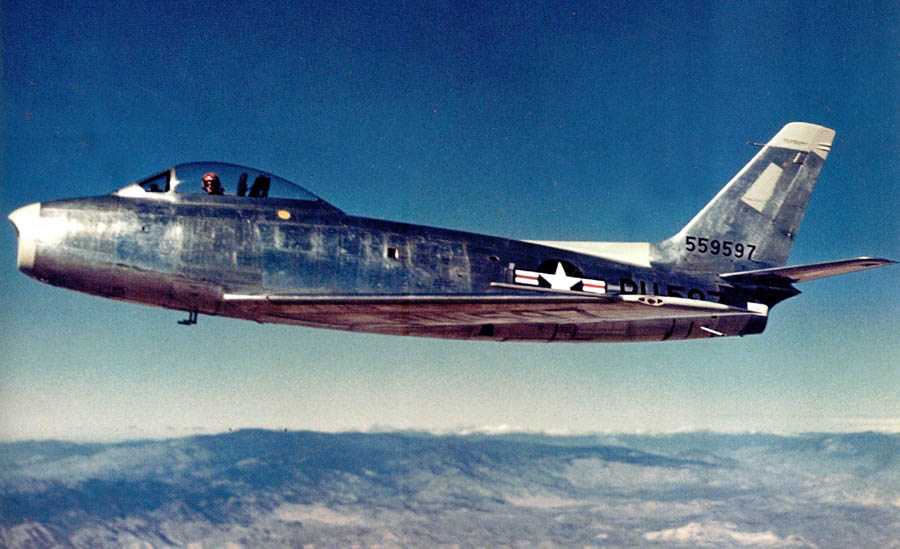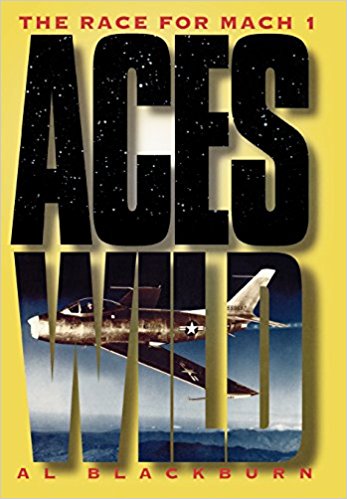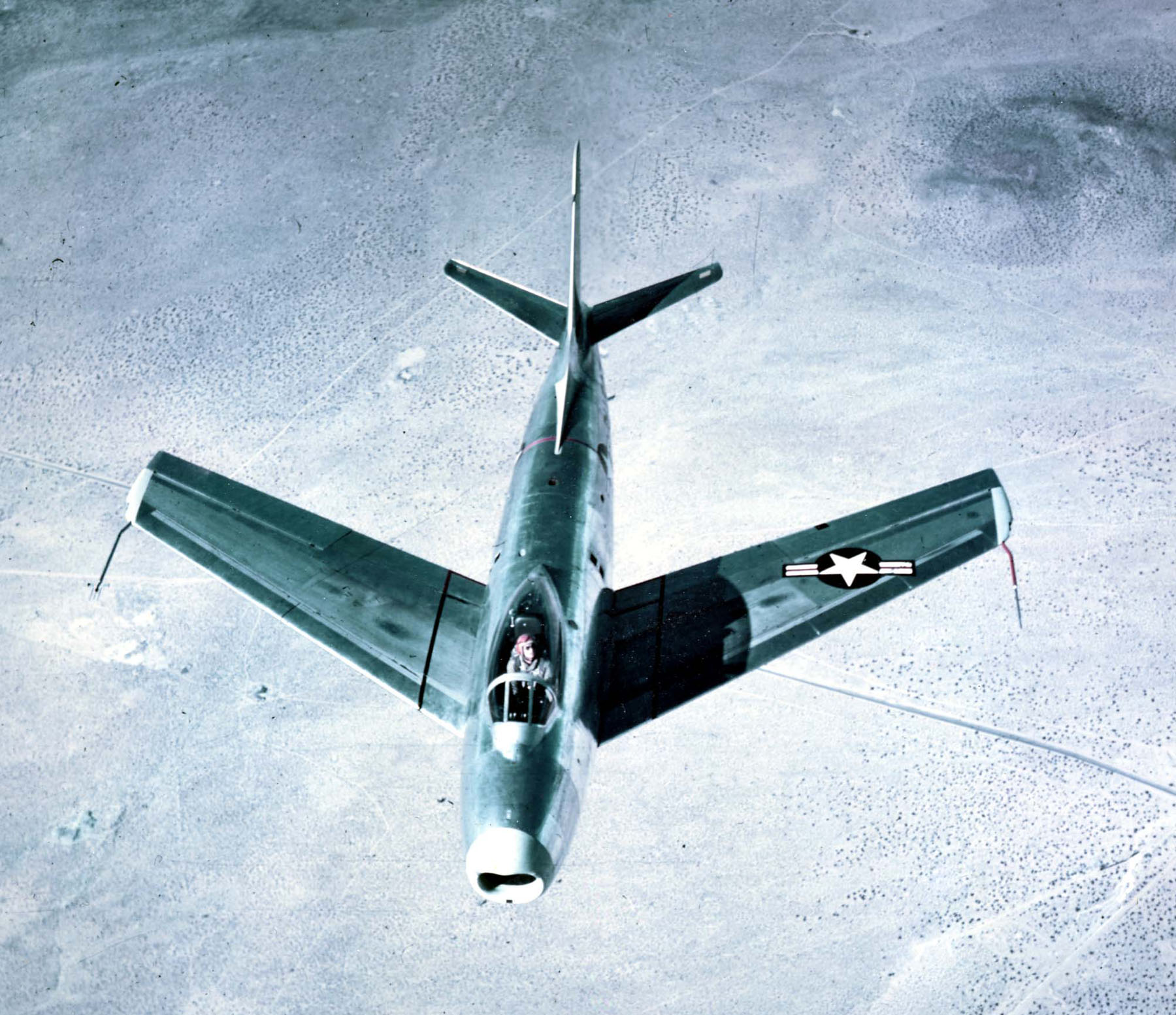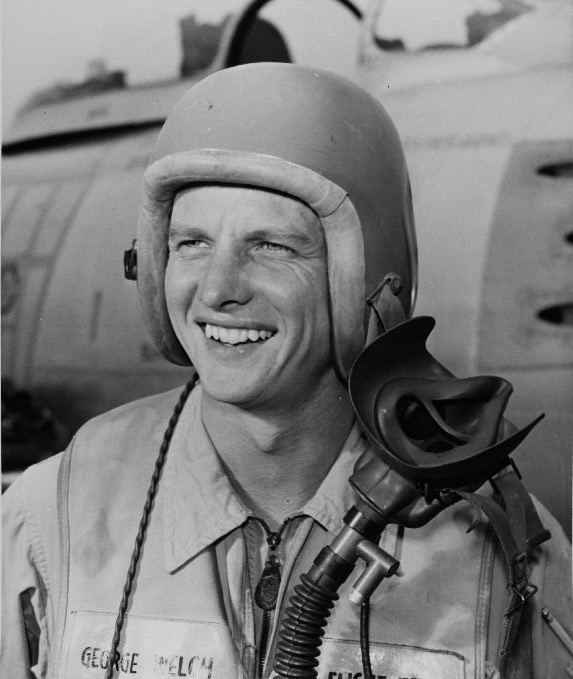
26 April 1948: At Muroc Field (now known as Edwards Air Force Base), in the high desert of southern California, North American Aviation test pilot George Welch put the prototype XP-86 Sabre, 45-59597, into a 40° dive and broke the Sound Barrier. It is only the second U.S. aircraft to fly supersonic. The first was the Bell X-1, piloted by Chuck Yeager, only a few months earlier.
Or, maybe not.
 In his book, Aces Wild: The Race For Mach 1, fellow North American Aviation test pilot Albert W. Blackburn makes the case that George Welch had taken the prototype XP-86 Sabre supersonic on its first flight, 1 October 1947, and that he had done so three times before Chuck Yeager first broke the Sound Barrier with the Bell X-1 rocketplane, 14 October 1947. Blackburn described two runs through the NACA radar theodolite with speeds of Mach 1.02 and 1.04 on 13 November 1947.
In his book, Aces Wild: The Race For Mach 1, fellow North American Aviation test pilot Albert W. Blackburn makes the case that George Welch had taken the prototype XP-86 Sabre supersonic on its first flight, 1 October 1947, and that he had done so three times before Chuck Yeager first broke the Sound Barrier with the Bell X-1 rocketplane, 14 October 1947. Blackburn described two runs through the NACA radar theodolite with speeds of Mach 1.02 and 1.04 on 13 November 1947.
Mr. Blackburn speculates—convincingly, in my opinion—that Secretary of the Air Force W. Stuart Symington, Jr., ordered that Welch’s excursions beyond Mach 1 were to remain secret. However, during a radio interview, British test pilot Wing Commander Roland Prosper (“Bee”) Beamont, C.B.E, D.S.O. and Bar, D.F.C. and Bar, stated that he had flown through the Sound Barrier in the number two XP-86 Sabre prototype (45-59598). Once that news became public, the U.S. Air Force released a statement that George Welch had flown beyond Mach 1 earlier, but gave the date as 26 April 1948.

It wasn’t long after the first flight of the XP-86 on October 1, 1947, that Welch dropped into Horkey’s [Edward J. Horkey, an aerodynamicist at North American Aviation] office at the Inglewood plant. He wanted to talk about his recent flight and some “funny” readings in the airspeed indicator. He had made a straight-out climb to more than 35,000 feet. Then, turning back toward Muroc Dry Lake, he began a full-power, fairly steep descent.
“I started at about 290 knots,” Welch was explaining to Horkey. “In no time I’m at 350. I’m still going down, and I’m still accelerating but the airspeed indicator seems stuck like there’s some kind of obstruction in the pitot tube. I push over a little steeper and by this time I’m through 30,000 feet. All of a sudden, the airspeed indicator flips to 410 knots. The aircraft feels fine, no funny noises, no vibration. Wanted to roll off to the left, but no big deal. Still, I leveled out at about 25,000 and came back on the power. The airspeed flicked back to 390. What do you think?”
“. . . You may be running into some Mach effects. . . .”
— Aces Wild: The Race For Mach 1, by Al Blackburn, Scholarly Resources Inc., Wilmington, Delaware, 1999, at Pages 147–148.
The “funny” reading of the airspeed indicator became known as the “Mach jump.” George Welch was the first to describe it.
The Sabre became a legendary jet fighter during the Korean War. 9,860 were built by North American, as well as by licensees in Canada, Australia and Japan.
George Welch had been recommended for the Medal of Honor for his actions as a P-40 Warhawk fighter pilot in Hawaii, December 7, 1941. He was killed while testing a North American Aviation F-100A Super Sabre, 12 October 1954.

© 2018, Bryan R. Swopes
Am having trouble seeing the photos on the first view. At times they will show when I revisit the site.
Thanks, Anthony. This seems to happen now and then. It seems to be related to which search engine you use. My guess is that somewhere, a small software change has created a partial incompatibility with WordPress. The tech side is way above my pay grade, though. Try it again, or switch to a different browser.
So Yeager broke the sound barrier in sustained level flight while Welch broke it in a dive.
Yeager broke the Sound Barrier in a specially-built, rocket-powered experimental aircraft that had to be carried to launch altitude, and could fly only a few minutes at a time, while Welch broke it in a jet-powered fighter that would become one of the finest aircraft of its time.
Bryan,
I’m with you, Welch was first. The X-1 was a great research tool but it lost the race to Mach 1.
I do believe Welch was first. Sonic booms were heard at Muroc that morning.
I don’t disbelieve you. But were you there?
Secretary of the Air Force W. Stuart Symington, Jr. certainly seems to have had a penchant for altering the course of history. Look at what he did here with moving the “official date” of Welch’s historic test flight, and what he did to Jack Northrop’s Flying Wing program. Discontinuing a program is one thing, but to destroy all of the hard work by smelting down the XB/YB-35’s and YB-49’s on the spot in front of Northrup is incredibly mind boggling, not to mention just plain mean. The guy wouldn’t even let the Smithsonian have one of the copy’s, even after they requested one. Stuart Symington is one of the greatest mysteries of American Aviation.